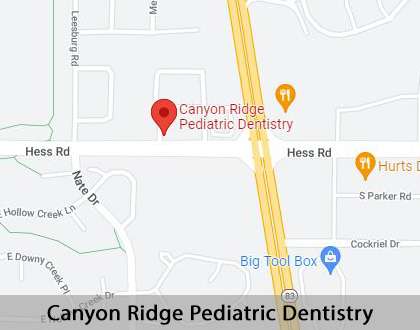Signs Your Child Has a Cavity Parker, CO
Tooth decay, also known as dental caries or cavities, represents a common problem in childhood. Tooth decay occurs when acids produced by bacteria break down or erode the outer layer or enamel of the tooth. Luckily, cavities caught early can be easily repaired.
Pediatric dentistry is available at Canyon Ridge Pediatric Dentistry in Parker and the surrounding area. We offer a range of dental and oral services for children and adolescents. Call us at (303) 841-7900 to learn more or make an appointment.
Sensitivity to Food Temperature
According to the United States Center for Disease Control and Prevention (CDC), cavities remain the most common chronic disease in children between ages six and eleven and teenagers. If children complain that their teeth hurt when drinking a hot soup or eating a popsicle, parents should suspect a cavity. To understand why tooth decay may cause temperature sensitivity, it helps to consider tooth anatomy. Underneath the top enamel layer of the tooth and the cementum (which lies under the gum) remains a layer called dentin.
According to the American Dental Association, dentin has small tunnels that lead directly to the tooth’s nerve root. When the top layer of the tooth decays and exposes the dentin, hot or cold temperatures can directly impact the nerve, causing hypersensitivity.
“To understand why tooth decay may cause temperature sensitivity, it helps to consider tooth anatomy.”
Visible Hole, Chip, Crack, or Pit in the Teeth
Tooth bacteria appear in thin films on the teeth called plaque. Plaque covers the outer enamel layer of the teeth. Plaque can be brushed away mechanically and kept at bay with flossing and mouth washing. However, if plaque sits on the teeth surface for too long, it can begin degrading the enamel.
If the decay progresses far enough, it can cause visible changes. These cavities might appear as a hole, chip, crack, or pit in the teeth. In most cases, patients need to replace their natural tooth with a crown or other tooth-replacement option. Otherwise, the dentist may fill in the hole, chip, crack, or pit with a composite material and bond it to the teeth.
“If plaque sits on the surface of the tooth for too long, it can begin degrading the enamel.”
Gum Pain and Bleeding
If a child complains of gum pain, this may be a sign of a cavity. Cavities can occur underneath the surface of the gum line when the protective layer of cementum decays. A cavity underneath the gum line can directly irritate the gum tissue and cause pain. However, gum pain may also result from a primary inflammation of the gum itself, a condition known as gingivitis.
Bleeding of the teeth can stem from a large cavity that has caused an infection of the underlying tissue of the tooth. Bleeding can also come from gingivitis. Gingivitis and cavities can share a root cause, so it remains critical to have children evaluated by a dentist if complaining of bleeding.
“A cavity underneath the gum line can directly irritate the gum tissue and cause pain.”
Check out what others are saying about our dental services on Yelp: Signs Your Child Has a Cavity in Parker, CO
Pain While Chewing
If a child has pain while chewing, this could be another sign of a cavity. Cavities represent a defect in the outer surface of the tooth. When a child chews food, small particles can enter the cavity and irritate the underlying tissues, causing pain.
According to the American Association of Endodontists, large cavities can also cause an infection of the deeper tissues of the tooth so that chewing can be painful even without lodged food particles. Large cavities require immediate attention as they can advance to become root canals if they touch the roots of the teeth. In these cases, the child will likely lose the tooth and require a root canal and crown.
“When a child chews food, small particles can enter the cavity and irritate the underlying tissues, causing pain.”
Questions Answered on This Page
Q. Why do cavities cause tooth sensitivity?
Q. What do cavities look like?
Q. Are gum pain or bleeding signs of a cavity?
Q. Is pain while chewing a sign of a cavity?
Q. Is a color change of the tooth a sign of a cavity?
People Also Ask
Q. What are some early warning signs of cavities?
Dark Spots or White Spots
A color change of a tooth may signal a cavity. As the enamel of the tooth decays, it can become discolored with either dark spots or white spots. The color change can continue as the underlying structures of the tooth, such as dentin, become exposed.
However, dark or white spots can also result from routine staining of the enamel, so it is important to have any tooth discoloration examined by a dentist. When enamel erodes, it exposes dentin, which is yellow in color, emitting that yellow-ish color. The discoloration is often due to staining agents such as coffee, tea, soda, certain juices, and smoking.
“The color change can continue as the underlying structures of the tooth, such as dentin, become exposed.”
Frequently Asked Questions
Q. What is the difference between a cavity and caries?
A. Dental caries and dental cavities are interchangeable terms that both indicate tooth decay. However, each patient may struggle with varying levels of cavities. Thus, seeking immediate dental care and regular checkups can help to prevent a condition from causing further damage.
Q. What will happen if a child does have a cavity?
A. If a dentist identifies a cavity in a child, the dentist will first do a diagnostic evaluation to assess the cavity size. Then a dentist will prepare the tooth and fill it or recommend a more in-depth procedure.
Q. What will happen if a child does not get a cavity repaired?
A. A cavity not repaired can grow larger, eventually causing a large hole in the tooth. This hole may infect the deeper structures of the tooth, necessitating a more involved procedure called a root canal.
Q. How can I help my child prevent cavities?
A. You can help children prevent cavities in many ways. Begin wiping the gums of infants twice daily before the teeth even emerge. Continue this practice with a toothbrush after the teeth erupt. Encourage children over age two to brush twice a day (after breakfast and before bed) with a fluoridated toothpaste. Children should also begin flossing once the teeth touch and visit a dentist regularly.
Q. Can cavities occur in baby teeth?
A. Yes, cavities occur when the enamel of the tooth decays. Baby teeth have the same enamel covering as adult teeth, so they remain susceptible to cavities.
Quality Pediatric Dental Services Can Transform Smiles
By visiting us as soon as possible, our team can help get your child the professional treatment they need.
Definition of Pediatric Dental Terminology
Call Us Today
While the above signs remain typical of cavities, a diagnosis can only be made by a dentist after a thorough check-up. If a child displays signs of a cavity, parents should schedule a dental appointment as soon as possible. Call us at 303-841-7900 to learn more about our services, speak to call Canyon Ridge Pediatric Dentistry, or book an appointment.
If you live in the Parker area, call 303-841-7900 for an appointment in our Parker office.
Helpful Related Links
- American Dental Association (ADA). Glossary of Dental Terms. 2023
About our business and website security
- Canyon Ridge Pediatric Dentistry was established in 2012.
- We accept the following payment methods: American Express, Cash, Check, Discover, MasterCard, Paypal, and Visa
- We serve patients from the following counties: Douglas County
- We serve patients from the following cities: Parker, Centennial, Castlewood, Southglenn, Castle Rock, and Highlands Ranch
- Healthgrades. View Background Information and Reviews
- Norton Safe Web. View Details
- Trend Micro Site Safety Center. View Details







